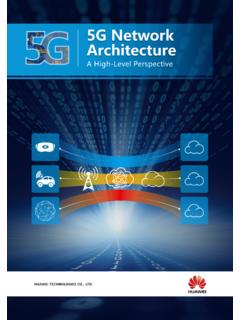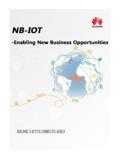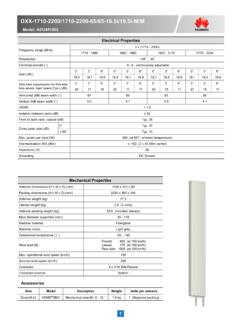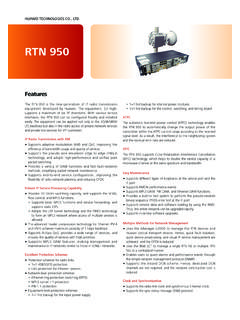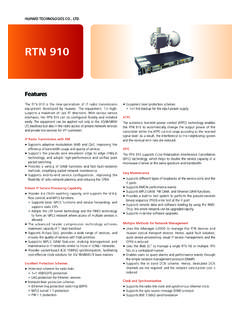Transcription of Huawei S9300 Switch Product Brochures
1 Huawei S9300 Switch Product Brochures Issue Date 2015-08-03. Huawei Technologies Co., Ltd. S9300 Series Terabit Routing Switches S9300 Series Terabit Routing Switches Product Overview Huawei S9300 series ( S9300 for short) terabit routing switches are next-generation high-end smart switches tailored for multiservice networks. The S9300 uses Huawei 's intelligent multilayer switching concept to provide high-performance L2/L3 switching services as well as rich network applications such as High-Definition (HD) video, elastic cloud computing, hardware IPv6, unified security, and H-QoS. Secure, reliable, and scalable, and providing converged, end-to-end routing and switching functions, the S9300 switches are widely used in Wide Area Networks (WANs), Metropolitan Area Networks (MANs), and data centers to help carriers build application-centric networks.
2 The S9300 is available in three models: S9303, S9306, and S9312. All S9300 models use interchangeable modules and components for inexpensive switching capacity and port expansion. In addition, S9300 models use innovative energy saving technologies that greatly reduce energy consumption and noise without compromising performance or stability. An S9300 running a system software version of V2R5C00 or later can be upgraded to an agile Switch by using an X1E card, which is equipped with the first Ethernet Network Processor (ENP) of Huawei . S9303 S9306 S9312. Product Features Agile Switch , Enabling Networks to Be More Agile for Services The high-speed ENP is tailored for Ethernet networks.
3 The ENP's flexible packet processing and traffic control capabilities can meet current and future service requirements and help build a highly scalable network. The ENP has a fully programmable architecture, in which customers can define their own forwarding models, forwarding behaviors, and lookup algorithms. Microcode programmability enables new services to be provisioned within six months, without the need of replacing the hardware. In contrast, with traditional ASIC chips, new services cannot be provisioned until new Issue (2015-08-03) Huawei Proprietary and Confidential Page 2 of 9. Copyright Huawei Technologies Co.
4 , Ltd. S9300 Series Terabit Routing Switches hardware is developed to support the services, which may take 1 to 3 years, because ASIC chips use a fixed forwarding architecture and follow a fixed forwarding process. By using an X1E board, the S9300 supports the unified user management function to authenticate both wired and wireless users, ensuring a consistent user experience regardless of whether they use wired or wireless access devices to connect to the network. The unified user management function supports various authentication methods, including , MAC, and Portal authentications, and is capable of managing users based on user groups, domains, and time ranges.
5 This function visualizes user and service management and enables the transformation from device-centric management to user-centric management. The X1E board supports the Packet Conservation Algorithm for Internet (iPCA) function, which changes the traditional method of using simulated traffic for fault location. iPCA. technology can monitor network quality for any service flow at any network node, at any time, and without extra costs. It can detect temporary service interruptions in a very short time and precisely identify faulty ports. This cutting-edge fault detection technology turns "extensive management" to "fine granular management.
6 ". Innovative CSS Technology S9300 switches can set up a clustering Switch system (CSS) through cluster cards or service ports. The CSS provides industry-leading 256 Gbps inter-chassis bandwidth due to Huawei 's novel approach of using the switching fabric clustering technology in CSS. Member switches can be connected through the service ports on LPUs. These service ports can be configured as stack member ports and added to a logical stack port to enable connection through SFP+ optical modules and fibers, or direct connection through SFP+. stack cables. Virtualization technology improves link use efficiency and prevents single-point failures through inter-chassis link aggregation.
7 The S9300 uses route hot backup technology to back up and uninterruptedly forward all data of the control and data planes at Layer 3. This technology significantly improves reliability and performance of the S9300 . The inter-chassis links in a CSS can be bundled to improve link use efficiency and eliminate single-point failures. The S9300 can use common service ports as cluster ports, and member switches can be connected through optical fibers. This increases the permitted distance between switches in the CSS. All member switches in a CSS are managed through a single IP address, which simplifies network device and topology management, improves network operation efficiency, and reduces maintenance costs.
8 Carrier-Class Reliability The S9300 's key components, such as MPUs, power supplies, and fans trays, use a redundant design, and all modules are hot swappable to ensure stable network running. The S9300 supports ms hardware-based BFD for static routes and routing protocols such as RIP, OSPF, BGP, IS-IS, VRRP, PIM, and MPLS. Hardware-based BFD. significantly improves network reliability. The S9300 supports hardware-based Ethernet OAM in compliance with IEEE , , and ITU-Y. 1731. Hardware-based Ethernet OAM can collect precise network parameters, such as transmission latency and jitter, to help customers monitor network operating status in real time and to realize fast fault detection, location, and failover.
9 The S9300 supports Graceful Restart (GR) technology to implement nonstop forwarding (NSF) and ensure reliable and high-speed operation of the entire network. Powerful Service Processing Capabilities . Issue (2015-08-03) Huawei Proprietary and Confidential Page 3 of 9. Copyright Huawei Technologies Co., Ltd. S9300 Series Terabit Routing Switches The S9300 provides high-density 10GE ports and provide 2 x 100GE line card, Each S9312 chassis can provide a maximum of 480 x 10GE ports and 24 x 100GE ports, meeting the requirements of bandwidth-consuming applications, such as multimedia conferencing and data access.
10 Based on a multi-service routing and switching platform, the S9300 provides wireless access, voice, video, and data services for network access, aggregation, and core layers, helping customers build a highly reliable, low-latency, and multi-service network. The S9300 supports distributed MPLS L2/L3 VPN functions including MPLS, virtual private LAN service (VPLS), hierarchical VPLS (HVPLS), and virtual leased line (VLL), to provide secure access for VPN users. The S9300 supports comprehensive Layer 2 and Layer 3 multicast protocols, including Protocol Independent Multicast Sparse Mode (PIM SM), PIM Dense Mode (DM), PIM.
